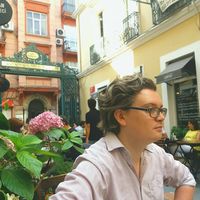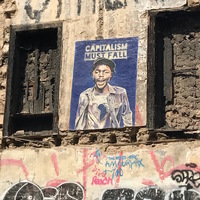Papers by Apostolos Papadimitriou
H βόρεια κλιτύς της Ακρόπολης: ένα αρχαιολογικό παλίμψηστο Επιστημονική συνάντηση (Περιλήψεις)
Ανακοίνωση στην Επιστημονική συνάντηση., Η Βόρεια κλιτύς της Ακρόπολης: ένα αρχαιολογικό παλίμψησ... more Ανακοίνωση στην Επιστημονική συνάντηση., Η Βόρεια κλιτύς της Ακρόπολης: ένα αρχαιολογικό παλίμψηστο. Μουσείο Παύλου και Αλεξάνδρας Κανελλοπούλου 19-21 Οκτωβρίου 2023
by Arthur MULLER, Dora Katsonopoulou, Michèle BRUNET, Mario Denti, David Tandy, Antonio Corso, Petya Ilieva, Bozidar Slapsak, Hasan Kasapoğlu, Martin Perron, Apostolos Papadimitriou, Tony Kozelj, and Giorgos M. Sanidas Volume of Abstracts of papers presented at the Paros IV International Conference on the Archaeolo... more Volume of Abstracts of papers presented at the Paros IV International Conference on the Archaeology of Paros and the Cyclades, 11-14 June 2015, Paroikia, Paros
Coins from a Building of Ancient Ambracia
A Hellenistic Acropolis at Anemorrakhi, Tzoumerkiotika Chronika 14, 169-181, Athens.
Λόγος και εικόνα στην εξέλιξη της τέχνης των εικονογραφημάτων **
An Initial Classification of the Ceramic Material from the Plot of Emm. Sarris at «Tholos» Site, ... more An Initial Classification of the Ceramic Material from the Plot of Emm. Sarris at «Tholos» Site, Paroikia Paros), Pariana 12, 5-14, Athens
Workshops at the Plot of Emm. Sarris at Paroikia Paros and Their Relations to the Adjacent Worksh... more Workshops at the Plot of Emm. Sarris at Paroikia Paros and Their Relations to the Adjacent Workshops), Pariana 125 , 170-179, Athens
The Rock Shelter at Asprokhaliko. Notes on the Relations between Archaeology and Environment) , P... more The Rock Shelter at Asprokhaliko. Notes on the Relations between Archaeology and Environment) , Prevezanika Chronika 45-46, 9-23, Preveza.
The East- West Pattern and the Art of F. Kontoglou. On the occasion of the Despotic Icons at the ... more The East- West Pattern and the Art of F. Kontoglou. On the occasion of the Despotic Icons at the Marble Iconostasis of Sotiros Church at the Area of Pantokratoras, Preveza), Prevezanika Chronika 43- 44, 301- 348, Preveza
The Iconography of Aghios Christoforos During 14th, 15th and 16th Centuries), Periapto 2, 7-18, A... more The Iconography of Aghios Christoforos During 14th, 15th and 16th Centuries), Periapto 2, 7-18, Athens.
Books by Apostolos Papadimitriou
The Archaeological Site of Nikopolis. History- Monuments- Art. Archaeological Guide [in collabora... more The Archaeological Site of Nikopolis. History- Monuments- Art. Archaeological Guide [in collaboration with O. Karouta], Preveza
Book Reviews by Apostolos Papadimitriou
TlSpiaTETO 109 AiaKOG^tiTiKTi ZcoypacpiKfi. BalKdvia -MiKpd Aaia 18o(; -19o(; aicovaig MiXxoq fap... more TlSpiaTETO 109 AiaKOG^tiTiKTi ZcoypacpiKfi. BalKdvia -MiKpd Aaia 18o(; -19o(; aicovaig MiXxoq fapiSrii;, EKSOOSK; M8X,i0oa, A9r|va, 1996 n pOKeiiai yia ^iia sn;repioTaTco|aevTi Epyaoia TOU aeinvrioiou M. FapiSr), Ttou Tr|v xapaKxr\p\C,£.\,
Book Illustrations by Apostolos Papadimitriou
Εκπαιδευτικό πρόγραμμα της ΕΦΑ ΚΥΚΛΑΔΩΝ
Ανακαλύπτουμε το αρχαιολογικό μουσείο Κύθνου. Η Ιστορία τ... more Εκπαιδευτικό πρόγραμμα της ΕΦΑ ΚΥΚΛΑΔΩΝ
Ανακαλύπτουμε το αρχαιολογικό μουσείο Κύθνου. Η Ιστορία της Κύθνου μέσα από τα αρχαία ευρήματα
Γενικός Συντονισμός: Δ. Αθανασούλης
Κείμενα: Θ. Παπαγγελοπούλου
Σχεδιασμός εντύπου: Ε. Παπαδέα
Εικονογράφηση Α. Παπαδημητρίου (απόστολος)
Διαδραστικό εκπαιδευτικό πρόγραμμα
Συντονισμός Α.Λαζαρίδου και Β. Παπαγεωργίου
Κείμενα Α. Τσιτο... more Διαδραστικό εκπαιδευτικό πρόγραμμα
Συντονισμός Α.Λαζαρίδου και Β. Παπαγεωργίου
Κείμενα Α. Τσιτούρη, Τ. Φουρτούνη
Σκίτσα: Α. Παπαδημητρίου (απόστολος)











Uploads
Papers by Apostolos Papadimitriou
Books by Apostolos Papadimitriou
Book Reviews by Apostolos Papadimitriou
Book Illustrations by Apostolos Papadimitriou
Ανακαλύπτουμε το αρχαιολογικό μουσείο Κύθνου. Η Ιστορία της Κύθνου μέσα από τα αρχαία ευρήματα
Γενικός Συντονισμός: Δ. Αθανασούλης
Κείμενα: Θ. Παπαγγελοπούλου
Σχεδιασμός εντύπου: Ε. Παπαδέα
Εικονογράφηση Α. Παπαδημητρίου (απόστολος)
Συντονισμός Α.Λαζαρίδου και Β. Παπαγεωργίου
Κείμενα Α. Τσιτούρη, Τ. Φουρτούνη
Σκίτσα: Α. Παπαδημητρίου (απόστολος)
Ανακαλύπτουμε το αρχαιολογικό μουσείο Κύθνου. Η Ιστορία της Κύθνου μέσα από τα αρχαία ευρήματα
Γενικός Συντονισμός: Δ. Αθανασούλης
Κείμενα: Θ. Παπαγγελοπούλου
Σχεδιασμός εντύπου: Ε. Παπαδέα
Εικονογράφηση Α. Παπαδημητρίου (απόστολος)
Συντονισμός Α.Λαζαρίδου και Β. Παπαγεωργίου
Κείμενα Α. Τσιτούρη, Τ. Φουρτούνη
Σκίτσα: Α. Παπαδημητρίου (απόστολος)
Τα αντικείμενα καλύπτουν χρονολογικά μια εκτεταμένη περίοδο από τα ύστερα κλασσικά έως τα νεώτερα χρόνια (19ος αι.). Στο γενικό σύνολο της παράδοσης ξεχωρίζουν δύο κύρια υποσύνολα νομισμάτων της Ελληνιστικής και Ρωμαϊκής εποχής αντίστοιχα που απαρτίζουν και το μεγαλύτερο ποσοστό του ευρύτερου συνόλου. Τα χαλκά της Ελληνιστικής περιόδου είναι στη συντριπτική πλειοψηφία τους Παριανές κοπές μικρής αξίας αλλά εξαιρετικής αρχαιολογικής σημασίας.
Παρά το γεγονός ότι προέρχονται από επιφανειακή περισυλλογή και όχι από ανασκαφικό περιβάλλον απ’ όπου θα μπορούσαν να προκύψουν περισσότερα συμπεράσματα σχετικά με την νομισματοκοπεία και την ιστορία του νησιού, εντούτοις παραμένει ενδιαφέρουσα η επιστημονική προσέγγισή τους δεδομένης της πλήρους έλλειψης παραλλήλων από τις ανασκαφές. Τα γνωστά παράλληλα από την Πάρο αποτελούν είτε αποκτήματα των μεγάλων κρατικών συλλογών (που συγκροτήθηκαν από το 18 έως τις αρχές του 20ου αι.) των Μουσείων της Ευρώπης είτε είναι γνωστά από δημοπρασίες του εξωτερικού με πλήρως αποσπασματικά στοιχεία για την προέλευσή τους και τις συνθήκες ευρέσεώς τους. (χωρίς καμία απολύτως περαιτέρω πληροφόρηση). Με την βοήθεια σύγχρονων αναλυτικών μεθόδων έγινε προσπάθεια προκειμένου να ερευνηθούν αφενός η μέθοδος καθαρισμού των νομισμάτων που δεδομένα είχε εφαρμοσθεί σε αυτά κατά το παρελθόν, πριν από την παράδοσή τους, και αφετέρου να προσδιορισθεί το δυνατό καλύτερα η χημική τους σύσταση. Τα αποτελέσματα των αναλύσεων σε ένα δείγμα είκοσι οκτώ νομισμάτων από το σύνολο αυτών, οδήγησαν σε μια σειρά συμπερασμάτων τόσο ως προς την αρχική επέμβαση συντήρησης όσο και ως προς την χημική τους σύσταση.
Πρωταρχικά στην ανακοίνωση θα πραγματοποιηθεί προσέγγιση στον χαρακτήρα του νότιου νεκροταφείου στο σύνολό του, η χωροθέτησή του και η σύγκρισή του με το επίσημο βόρειο νεκροταφείο στη θέση «Βίτζι». Δευτερογενώς θα γίνει προσπάθεια να αναπτυχθούν σειρά προβληματισμών, όπως οι λόγοι της αρχικής επιλογής του χώρου στα ανατολικά, η πιθανή και γρήγορη εγκατάλειψή του με τη ταυτόχρονη πυκνότητα ταφών προς τα δυτικά. Επίσης θεμελιώδες ζήτημα είναι οι λόγοι ανάπτυξης του νότιου νεκροταφείου. Είχε σχέση με την εγγύτητα κάποιας συνοικάς στα προάστια της πόλης, με την ταξική προέλευση των νεκρών, με την πιθανή πληθυσμιακή έκρηξη των αρχαίας πόλης η οποία επέβαλε τη χωροθέτηση προς το νότο, ή συσχετίζονταν με το χώρο του Ασκληπιείου και του Πύθιου που βρίσκεται πολύ κοντά σ’ αυτό;
Preliminary excavation results from part of the south cemetery in Paros Island. Thoughts and questions
During the two excavation periods, one in December 2011 and the second between May and June 2015, due to the construction of a new building, a site situated at “Stauros” in Paroikia Paros, was excavated. The excavation revealed part of the south cemetery, which is extended at the SE of the town as well. In particular, ten burials of several types were revealed in total. These burials are dated from the 4th BC until Late Roman times. The majority of them are particulary poor.
Primarily, the report will deal with the nature of the cemetery as a whole, its location and its comparison with the official north cemetery situated at "Vitzi". Secondarily, there will be an effort to develop a series of questions, such as the reasons for the initial choise at the East side, its possible and quick abandonment with the concurrent abundance of burieals at the West side. Moreover, another fundamental issue are the reasons of development of burials at the West side. Are there any corretlation with the proximity of a district in the city suburbs, with the social provenance of the deccased, with a possible popoulation upsurge of the ancient city without imposed its south siting or was associated with the sanctuaries of Asxlepius and Apollo Pythios which were situated in close proximity to it?
Subsequently, the discovery of a craft production installation at the site of Alimos, just 4 kilometers south of the Athenian Acropolis, has provided a wealth of new evidence, including kiln wasters, suggesting the manufacture of a range of ceramic vessel types similar to those identified to be of an Attic origin. Preliminary examination through thin-section petrography coupled with traditional typological fabric analysis indicates that the pottery produced at Alimos includes specialized vessel types such as fine tablewares, quality cooking vessels and tubs in a range of sizes with a wide distribution of entire assemblages reaching at least as far as Thorikos in southeast Attica, Kanakia in the west and perhaps farther into the Aegean world during the LH IIIB period.
The scope of this paper is to illuminate that the distribution of pottery in Attica and parts of the Saronic Gulf during the LH IIIB period through characterizations of the ceramic material that we have identified to have been manufactured at Alimos through the use of thin-section petrography. Consumption patterns of ceramics in and around the gulf supply new and exciting information that provides key insight about the inter- and intra-regional relationships during a period of prehistory where craft production and distribution is usually considered to have been centrally controlled by local palatial centers. Finally, by concentrating on the production and movement of entire assemblages, we attempt to locate the place of the potter’s craft within the palatially centered Mycenaean society.
"
Η σωστική ανασκαφή πραγματοποιήθηκε το έτος 2006 στα πλαίσια κατασκευής σύγχρονης οικοδομής. Κατά τις εργασίες αποκαλύφθηκε τμήμα οικίας της αρχαίας Αμβρακίας στην οποία διακρίνονται τρεις διαφορετικές χρονολογικά φάσεις. Επίσης αποκαλύφθηκε τμήμα και της περιμετρικής οδού εσωτερικά του τείχους και τμήμα αυτού. Η ανασκαφή ενοποιείται με τα αρχιτεκτονικά λείψανα του όμορου οικοπέδου της οδού Μοστραίων (πρώην οικόπεδο ΤΕΙ), όπου εντοπίστηκαν και διατηρούνται έως σήμερα ιερό εκτός των τειχών και καλοδιατηρημένο τμήμα του τείχους
Στην ανακοίνωση παρουσιάζονται οι διαδοχικές χρονολογικά φάσεις, η σχέση του αποκαλυπτόμενου τμήματος της οικίας με το αρχαίο τείχος, την οδό εσωτερικά του τείχους και τα αρχιτεκτονικά λείψανα του όμορου οικοπέδου. Επίσης γίνεται λόγος για τα ευρήματα καθώς και ενδεικτικά για τη κεραμεική στο χώρο.
Απόστολος Σπ. Παπαδημητρίου
Αρχαιολόγος ΚΑ΄ΕΠΚΑ
Excavation on the plot Panoutsou Arta (ancient Ambrakia)
The excavation took place in 2006 under construction modern building. At the work revealed part of the ancient house of Ambrakia in which distinguished three different chronological phases. Also the excavation works revealed the part of an ancient road segment inside the walls. The architectural finds of the excavation are associated with the architectural remains of the neighbor plot in the street “Mostraion”, which identified and preserved today extramural sanctuary and well preserved section of the ancient wall
In this paper presented the chronological phases of this ancient house, the relationship with ancient fortification, the interior road of the wall and the architectural remains of the neighbor plot. Also refer to the findings and representative pottery in this space.
Apostolos Sp Papadimitriou
Archaeologist in 21th Ephorate of Prehistoric and Classical Antiquities
Σάββατο 29 Αυγούστου 2015, Αρχαιολογικό Μουσείο Πάρου